Blogs
When my sixth child was two-years-old he started sleeping in his own room. Until then, he had slept with us, which was very handy for breastfeeding and early potty training, but once he began transitioning into his own space, I was on the hunt for the perfect room, and Montessori had the answer!
Order, simplicity, routine, and beauty -- the cornerstones of a Montessori-inspired toddler bedroom. Ahh! Just saying those four words together invokes a sense of inner peace, doesn't it? And if anyone could use some inner peace, it's the mom of a strong-willed two year old boy. You know what I'm saying?
Guiding Principles for Creating a Montessori Toddler Room
The Montessori education method was developed in the early 1900s by Italian physician and educator Maria Montessori. She believed that every child, from the moment of birth onward is filled with an enormous potential to learn and thrive -- far more than most adults can even imagine. By understanding a child's different development periods, which she called "Sensitive Periods," and tailoring their environment according the needs and opportunities of those periods, we can help kids fulfill their mental, spiritual, and physical potential. Dr. Maria Montessori believed that children are their own best teachers, and from that core understanding, she advocated the first principle that we'll use to create a Montessori Toddler Room -- it's the principle of "Follow the Child."
Follow the Child
Simply put, "follow the child" means observing the child's interests and taking into account their developmental level and abilities. When it comes to designing the toddler room, we can choose colors, pictures and toys that are likely to pique our child's interest. At two, my little guy loved anything locomotive. He also loved to build things (and then destroy them). Using the "follow the child" principle, a Montessori toddler room has toys stored on shelves that he can easily reach and includes toddler-size furniture that's easy for him to use.
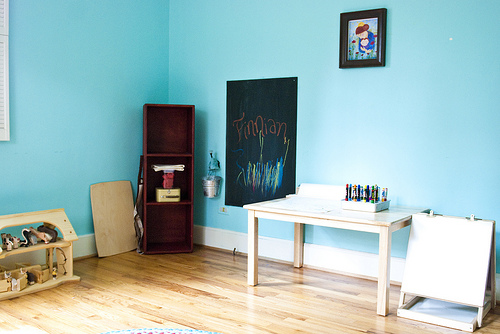
Freedom of Movement
Another Montessori principle is giving kids the opportunity to move about their space freely. So, when it comes to designing Matty Jay's room, I had to figure out how to use minimal furniture and leave lots of open space for playing and exploring.
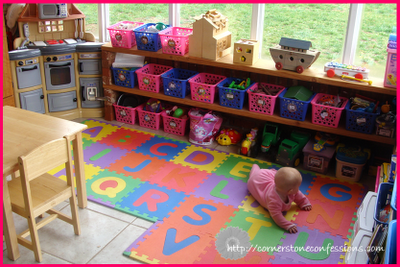
Freedom of choice
This is a big one in the Montessori world! Kids should follow their curiosity and have the freedom to make as many choices for themselves as possible. We couldn't agree more. In fact, freedom of choice shouldn't stop in the toddler years; it's a cornerstone of the C2C way all throughout childhood and adolescence and into adulthood. A well designed dressing area with clothing stored in a way that's easy for kids to see and reach gives toddlers the freedom to choose clothing. For my little guy, that meant two hooks on the wall at his eye level, where I was able to hang two outfit choices each day. Toys at eye level and a small basket with a few book choices give kids the ability to choose their own activities. For a toddler, the freedom to choose doesn't necessarily mean offering a ton of things. A limited variety of clothes, toys, shoes, stuffed animals, etc. makes choosing a little more manageable for them, which leads us to the next guiding principle.
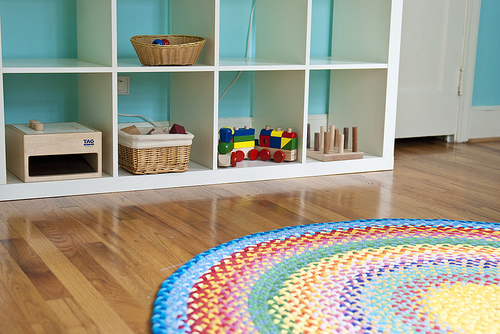
Order and Simplicity
Kids are overwhelmed by clutter -- both visual and physical clutter. They are more at peace and able to think and learn freely in an organized and simple environment. We're a homeschool family, and like most homeschool families, our house is probably a fire hazard with all the books we have. We've also got enough craft supplies to rival the nearest Michael's. But I'm learning that when everything is available all at once, it's massively overwhelming, especially for the younger ones. Below, we'll look at the different areas of a toddler's room, but one way to keep things orderly and simple for this age group is to rotate out toys and books, offering just a few choices at a time.
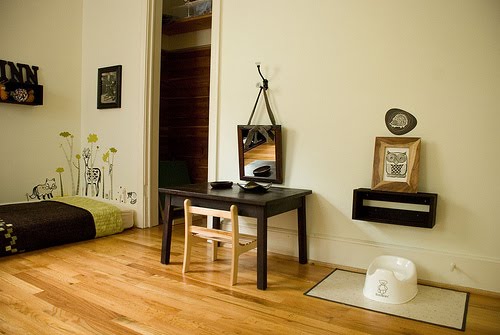
Independence
"I can do it all by myself!" That's a Montessori kid's mantra. So when I was planning Matty Jay's room, I focused on making it as 2-year-old user friendly as possible. His dressing area had a small bucket for dirty clothes, a toddler-size chair so he can put on his own shoes, and mirror at his eye level so he could check himself out. We stored toys on low shelves that were easy for him to see and reach and included a child-size table and chair for him to play and color on. We arranged his toys and books in ways that made it easy for him to be the master of his own day. Part of being independent in play means being able to decide how to use a toy. Toys that dictate how a child plays, which is the case with many electronic toys, undermine independence. Open play toys (construction toys, imagination toys, etc.) allow the child to dictate how he will use it, and they are the best choice for fostering independence in play.
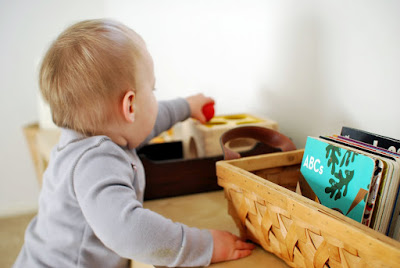
Beauty and Interest
Maria Montessori believed that a child's environment should stimulate interest and display beauty. As I researched for my son's toddler room, I noticed that most of the Montessori bedrooms included either wall murals that were at the child's eye level or framed artwork and artistic photographs hung at the toddler's eye level. Keeping kids interested can also happen by rotating out toys, books, and stuffed animals on a regular basis. But most importantly, it requires us to observe our kids carefully and pay attention to what captivates and intrigues them and then feed them more of those things!
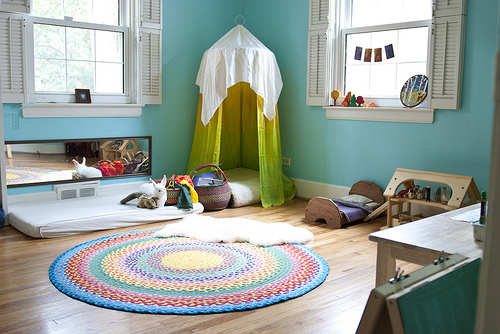
Basic Areas of a Montessori Toddler Room
Sleeping Area
The name "bedroom" alone reminds us that one of the main purposes of this room is for sleeping. But sleeping Montessori style looks a bit different than what most of us are used to. Typical Montessori rooms never use a crib or playpen because they violate so many of the guiding principles we just talked about: cribs and playpens inhibit movement and decision making and independence. They restrict the child to a very small area to explore, and distort the child's view of the room. Babies and toddlers are placed in a floor bed, where they can roll without restriction. Of course, safety is important, so outlets should be covered and dangerous things should be kept out of their path. If parents are concerned about little ones wandering around the house at night, consider using a gate at the doorway and a baby monitor. The sleeping area should be comfortable but simple. Easy for the toddler to get in and out of bed as needed. When my little tyke was potty training, we kept his potty chair near his bed so that he didn't have to go far in the middle of the night.
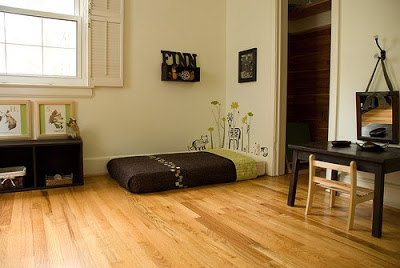
Dressing Area
Getting dressed and ready for our day typically happens in the bedroom. The dressing area should offer easy access to clothes and shoes, a small bench or chair for the toddler to sit on while they're putting on their shoes and a small container for laundry (big laundry baskets are not practical for little people -- a small one allows a toddler to fill it with dirty clothes and then empty it either in the laundry room or in the grown up laundry basket). The dressing area should have a good size mirror at the child's eye level so they can check out their style. And it might also have a small table and chair with a brush and maybe some hats or headbands.
Play Area
Play is a child's full time job! We've already talked a lot about choosing and displaying toys for kids in the Montessori way. As I was mining the internet for toddler room ideas, I came across this really cool idea for storing play activities and this one for storing and sorting crayons. The ideas are endless, as long as we keep in mind the toddler's interests and their ability to choose and play independently.
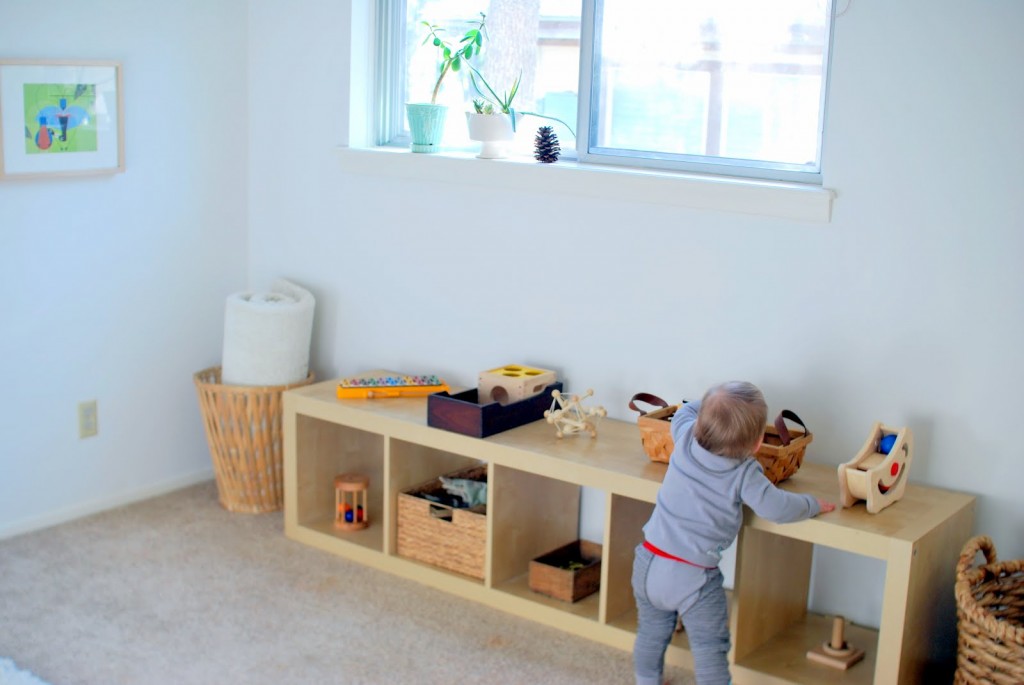
Reading Area
We are HUGE proponents of reading. Our older kids tend to polish off at least one book a week, and we still read aloud to all of our kids (even our teens). There is plenty of research out there that supports exposing kids to reading right from the start. A toddler's room should have a small basket with books available for their enjoyment -- books they can explore on their own and ones they can bring to an adult or older child to read. The Reading Area should also have a comfortable place for the toddler to sit and enjoy the books and good lighting.
Special Thanks!
A very special thanks goes out to Kenny Friedman of smonkyou.com for permission to use the featured image for this post. The inspiring picture that you see here is his son Miloh's room. A special thanks also to author and blogger Sara Cotner at FeedingTheSoil.com for the stunning pictures used in this post. Be sure to head over there and sign up get her inspiring emails! Another special thanks to author and blogger Meg McElwee at Sew Liberated for the colorful and imaginative pics of her children Finnian and Lachlan's Studio (such cool names!). If you're the creative sort (or wish to be), this seems to be the blog for you! And yet another special thanks also to Kathy Gossen at CornerstoneConfessions.com for allowing us to use one of her pictures for this post. Kathy has great tips for home organization, homeschooling, family life, personal growth and cooking.




Jenni Stahlmann and her husband Matthew have seven kids (ages 3 to 21), including one on the autism spectrum. They graduated their oldest two in 2017. In spite of significant cognitive challenges, their oldest is working full-time for a great company with great benefits. Their second child is entering her last year at the prestigious Berklee College of Music and is a Thrive Scholarship winner, honored as one of the students most likely to succeed! They are still homeschooling the remaining five with two high schoolers, one middle schooler, one elementary aged student and one preschooler. Jenni has been a journalist and professional writer for 25 years. She currently serves on the Board of Directors for her local homeschool organization and will be teaching a study skills and an advanced writing class at the local homeschool co-op using C2C curriculum.